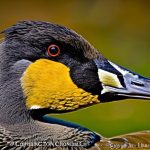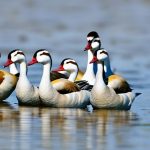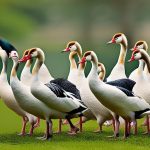Geese breeding has been a popular practice for centuries, with geese being raised for their meat, eggs, feathers, and even as pets. Breeding geese can be a rewarding and profitable venture, but it requires careful planning and consideration of various factors. Geese are known for their strong instincts and territorial behavior, making them relatively easy to breed compared to other poultry. However, successful breeding requires an understanding of different breeds, their compatibility, and genetic considerations. In this article, we will explore the world of geese breeding, including the different breeds, interbreeding, and the challenges and importance of successful breeding.
Understanding Different Breeds of Geese
There are numerous breeds of geese, each with its own unique characteristics and traits. Some of the most popular breeds include the Toulouse, Embden, Chinese, and African geese. Toulouse geese are known for their large size and excellent meat production, while Embden geese are prized for their white feathers and high egg production. Chinese geese are smaller in size and are often raised for their meat and eggs, while African geese are known for their aggressive nature and excellent foraging abilities. Understanding the different breeds of geese is essential for successful breeding, as it allows breeders to select the most suitable birds for their specific needs. Factors such as size, temperament, and productivity should be taken into consideration when choosing breeds for breeding purposes.
Can Different Breeds of Geese Interbreed?
One common question among geese breeders is whether different breeds of geese can interbreed. The answer is yes, most breeds of geese can interbreed, although there are some limitations and considerations to keep in mind. Interbreeding can result in hybrid geese with a combination of traits from both parent breeds. This can be advantageous in some cases, as it can result in geese with desirable characteristics such as increased size, better egg production, or unique color patterns. However, interbreeding can also lead to genetic issues and health problems in the offspring, so it should be approached with caution. Breeders should carefully consider the compatibility of different breeds before attempting to interbreed them, and should be aware of the potential risks and challenges involved.
Factors Affecting Interbreeding
Several factors can affect the success of interbreeding geese, including the genetic compatibility of the parent breeds, the health and fertility of the birds, and the breeding environment. Genetic compatibility is a crucial consideration when interbreeding geese, as some breeds may have genetic traits that are not compatible with others. Health and fertility are also important factors, as unhealthy or infertile birds are less likely to produce viable offspring. The breeding environment, including the availability of suitable nesting sites and the presence of predators, can also impact the success of interbreeding. Breeders should carefully assess these factors before attempting to interbreed geese, and should take steps to ensure the health and safety of the birds and their offspring.
The Importance of Interbreeding
Interbreeding geese can be important for the development of new breeds with desirable traits, such as increased size, better egg production, or unique color patterns. It can also help to preserve and improve existing breeds by introducing new genetic diversity. Interbreeding can result in hybrid vigor, which is the increased health and productivity of offspring due to the combination of traits from different breeds. This can be particularly beneficial for commercial breeders, as it can lead to geese that are more resilient and productive. Additionally, interbreeding can help to maintain genetic diversity within geese populations, which is important for the long-term health and sustainability of the species. Overall, interbreeding geese can play a crucial role in the development and improvement of geese breeds, and can contribute to the overall success of geese breeding programs.
Challenges of Interbreeding
While interbreeding geese can have many benefits, it also comes with several challenges and potential risks. One of the main challenges of interbreeding is the potential for genetic issues and health problems in the offspring. When two different breeds of geese are interbred, the resulting offspring may inherit genetic traits that are not compatible, leading to health issues and reduced fertility. Additionally, interbreeding can result in a loss of breed purity, which is a concern for breeders who are working to preserve and improve specific breeds. Another challenge of interbreeding is the difficulty of managing and maintaining hybrid geese, as they may have different care requirements and behavioral traits compared to purebred geese. Breeders should carefully consider these challenges before attempting to interbreed geese, and should be prepared to address any issues that may arise.
Successful Examples of Interbreeding
Despite the challenges, there have been many successful examples of interbreeding geese that have resulted in new breeds with desirable traits. One notable example is the development of the American Buff goose, which is a hybrid breed created by crossing Embden and Toulouse geese. The American Buff goose is known for its excellent meat production, calm temperament, and attractive buff-colored feathers. Another successful example is the development of the Pilgrim goose, which is a hybrid breed created by crossing Chinese and Embden geese. The Pilgrim goose is prized for its excellent egg production, calm temperament, and unique sex-linked feather coloration. These examples demonstrate the potential benefits of interbreeding geese, and the development of new breeds with desirable traits.
Genetic Considerations in Geese Breeding
Genetic considerations are crucial in geese breeding, particularly when it comes to interbreeding. Breeders should carefully assess the genetic traits and compatibility of different breeds before attempting to interbreed them. This can involve conducting genetic testing to identify potential issues and risks, and selecting breeds that are genetically compatible and complementary. Breeders should also be aware of the potential for genetic issues and health problems in the offspring of interbred geese, and should take steps to minimize these risks. Additionally, breeders should be mindful of the importance of maintaining breed purity and genetic diversity within geese populations, and should work to preserve and improve existing breeds through careful breeding practices.
Tips for Successful Interbreeding
There are several tips that can help breeders successfully interbreed geese and minimize the potential risks and challenges. First, breeders should carefully select breeds that are genetically compatible and complementary, and should avoid interbreeding breeds that are known to have genetic issues or health problems. Second, breeders should closely monitor the health and fertility of the parent birds, and should ensure that they are in optimal condition for breeding. Third, breeders should provide a suitable breeding environment, including access to suitable nesting sites and protection from predators. Finally, breeders should be prepared to address any issues that may arise during interbreeding, and should be proactive in managing and maintaining hybrid geese. By following these tips, breeders can increase the likelihood of successful interbreeding and the development of new breeds with desirable traits.
The Future of Geese Breeding
In conclusion, geese breeding is a complex and rewarding endeavor that requires careful consideration of different breeds, genetic compatibility, and breeding practices. Interbreeding geese can be important for the development and improvement of new breeds with desirable traits, and can contribute to the overall success of geese breeding programs. While interbreeding comes with several challenges and potential risks, there have been many successful examples of interbreeding that have resulted in new breeds with unique characteristics. By carefully assessing genetic considerations, monitoring the health and fertility of parent birds, and providing a suitable breeding environment, breeders can increase the likelihood of successful interbreeding and the development of new breeds with desirable traits. The future of geese breeding looks promising, with the potential for the development of new breeds that are more resilient, productive, and diverse. With careful planning and consideration, breeders can continue to improve and preserve geese breeds for generations to come.
Meet Walter, the feathered-friend fanatic of Florida! Nestled in the sunshine state, Walter struts through life with his feathered companions, clucking his way to happiness. With a coop that’s fancier than a five-star hotel, he’s the Don Juan of the chicken world. When he’s not teaching his hens to do the cha-cha, you’ll find him in a heated debate with his prized rooster, Sir Clucks-a-Lot. Walter’s poultry passion is no yolk; he’s the sunny-side-up guy you never knew you needed in your flock of friends!







